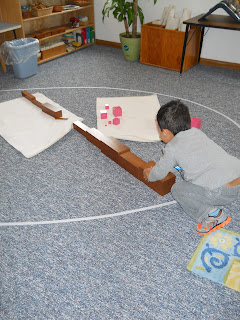He loved them! But he couldn’t hardly sit still through a vocab lesson and quickly lost interest when I needed to step away with another student.
 |
| Big 'pushing' work |
Enter fetching.
A simple exercise that swept through my classroom like wildfire and remains a favorite to this day! The children do it with me, an assistant, or best of all each other! One student spreads out the unlabeled cards at a table. The teacher or other students says “Bring me the Anklyosaurus”, showing the picture to match if the child isn’t sure what it is. When the first child brings it back they check that the cards match, then tuck them away in the pouches before going on to the next card. When all the cards are matched the game is over and the material is all ready to be put away.
3 part cards are the quintessential material to find online in droves. Seriously there are so many it’s overwhelming! You can find cards for different vehicles, animals of all kinds, foods, etc. ; just about anything you’d like. I can’t imagine finding a Montessori classroom that doesn’t include these cards in some form. They’re easy to make (or cheap to buy) and are so versatile. Here’s a quick summary of the 3 part classified cards.
What are they?
The classified cards consist of printed pictures and the vocabulary that goes with them. In my AMI training the cards consisted of a single card with just the picture on it, a second card with the picture and word all in one piece, and a third card containing the picture that matched to a separate label. However for some reason EVERY set of cards I find online doesn’t have this second card. I wish I would have known to ask in my training why we actually created 4 pieces for what are called 3 part cards! Does anyone else know the reasoning behind it?
Why do we use them?
The purpose of the classified cards is to help children build up their vocabulary and help categorize objects. For example there may be set of vegetable cards and fruit cards in the classroom to help children begin to distinguish which items belong to each category.
How do we use them?
Traditionally the cards are presented in a three period lesson for the children, exploring to see which words they already know and which ones they can learn. Here's a great summary of the Three Period Lesson. Above I explained how my first classroom evolved to have the cards be used mainly as a fetching/memory game.
After the students get better at the vocab it’s often fun to play the description/definition game. Spreading out the cards at a table or mat give some clues about which object you’re thinking about without using its name. Ex. “I’m thinking of something you might use to make a smoothie” “Blender!”
Tips for making the cards
 |
| Note the pink color coding to help keep this set from getting mixed up with other animal cards. |
- Color code them!
- Print the pictures on regular paper, then glue them to colored cardstock before laminating. So much easier than drawing dots on the back and it makes them sturdier too!
- Build a template
- I made a template in Word that simply allowed me to find the pictures I needed, insert them and quickly type the words underneath. Using a template made it not only faster to create new sets of cards, but insured they were all the same size to fit in my pouches.
- Sew universal pouches
- Ideally each set of cards has a pouch that shows what is inside (ex. fabric with different birds on it for bird cards) but let’s be honest and say that’s just not realistic. Years ago I invested in some fabric patterns that went nicely together, and made 5 sets of pouches that were identical and fit the cards sized in my template. Now when it’s time to rotate cards I can simply take the old ones out and put new ones in.
- Cut cards that are easy to tell apart
- Like I said, I was taught to make 3 copies of the picture and a matching label so there are actually 4 parts. After having numerous spills and trying to sort of cards I realized I’d missed something obvious that would make my life easier. Rather than trimming the 3nd card to be a square to go with the label I left the space where the word should go. This make it so there was always room for the children to place the label, and made sorting easier. Simply sort the cards into big and little; then separate the big cards into those with words and those without. If you’re going to make cards the AMI way I really recommend using this trick to save yourself some headaches.


No comments:
Post a Comment